A guide to Australia’s penguins

EIGHTEEN SPECIES OF penguin grace the Earth with their adorable presence, and a surprising number of them have an Australian connection. From the penguin parade of Phillip Island to the Australian research stations dotted along the coast of East Antarctica, we’ve rounded up eight species you should know about.
For this guide, we’ve included species with strong Aussie links. These penguins breed on the mainland, on Australia’s sub-Antarctic islands – Macquarie, Heard and McDonald – or within the Australian Antarctic Territory. Occasionally, other penguin species might pop by Australian territory while on their ocean wanderings.
Penguin places
Macquarie Island (“Macca”)
A windswept but ice-free sub-Antarctic island located 1,500km south of Tasmania.
Heard Island and McDonald Islands
Glacier-topped volcanic islands in the southern Indian Ocean, more than 4,000km southwest of Perth.
Australian Antarctic Territory
A substantial slice of the southernmost continent directly south of Australia, covering most of East Antarctica. The Australian Antarctic Division stations Mawson, Casey and Davis are dotted along the vast coastline.
Penguins in peril
Australia’s penguins have a tough life. Our mainland-dwelling little penguins face an array of threats: from introduced predators to humans inadvertently trampling burrows. Even the remote-dwelling penguins of the Southern Ocean aren’t immune to human impact. At sea, they may struggle to find food, facing competition with industrial fishing and changes in abundance and distribution of their prey due to climate change. Many penguin rookeries (breeding sites) are protected places, and a number of marine protected areas are proposed for East Antarctica to help our penguin pals.
Little penguin
Eudyptula minor
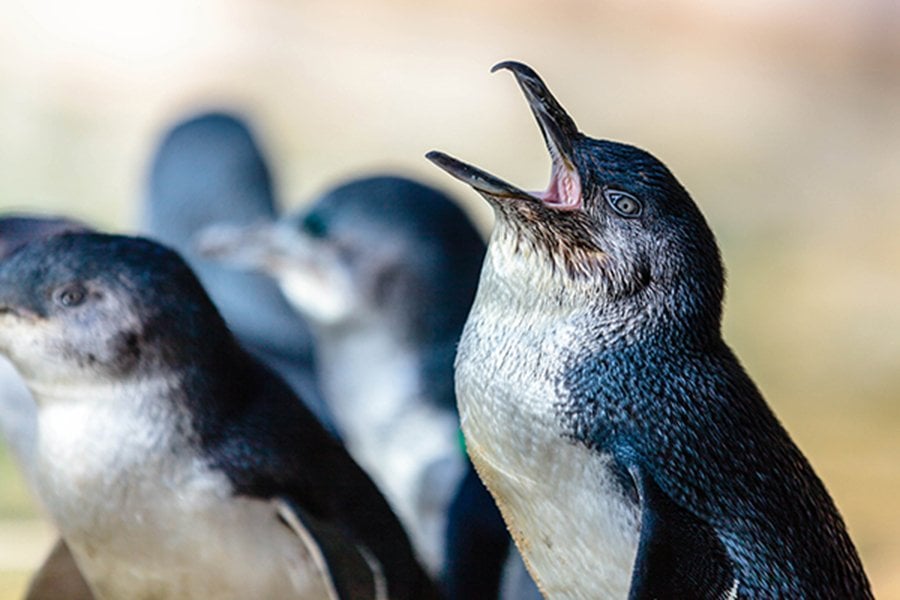
(Image Credit: Darren Puttock/Flickr)
Only a tad bigger than a bowling pin, little penguins (sometimes called fairy penguins) are the smallest penguin species in the world. These petite paddlers make their homes along the coast of southern Australia, with colonies located on Montague Island and Sydney’s Manly Beach in NSW, the St Kilda breakwater in Melbourne, Victoria’s Phillip Island and the aptly-named Penguin Island in WA (among others).
Each morning, little penguins will leave their burrow to spend the day fishing at sea. Over the day, they’ll travel up to 20km in search of fish, cephalopods and crustaceans. After dusk, they return home in “rafts” and scurry across the beach in a “penguin parade”.
Most little penguin colonies are located on offshore islands, where they are somewhat safer from introduced predators like cats and foxes. Uncontrolled dogs also pose a threat to little penguins, as does human disturbance. Eradication programmes and specially-trained guard dogs are some of the ways we’re trying to protect these pint-sized penguins.
King penguin
Aptenodytes patagonicus

(Image Credit: Ellen Rykers)
King penguins are the second-largest penguin species (after emperor penguins), measuring up to one metre tall. But kings are more eye-catching, with vivid markings reminiscent of a tropical sunset.
King penguins live on both Macquarie Island, and Heard Island and the McDonald Islands. Here, they form chatty colonies in ice-free areas to moult and mate. King penguins have a peculiarly prolonged breeding cycle, with the period from egg-laying to chick-fledging lasting up to 16 months – the longest of any penguin. Like their emperor relatives, king penguins incubate their eggs on their feet. Once the chicks are big enough, they form “crèches”. At this stage, chicks wear a thick coat of brown down. They look so different from their streamlined parents that early European explorers thought they were a separate species, which they called “woolly penguins”!
King penguins forage for fish at the Antarctic Polar Front – a region rich in tasty lanternfish, the kings’ preferred food. They will dive up to 100 times per day, reaching speeds of 12km/h in pursuit of a meal. King penguins have been observed diving to depths greater than 300m, and in excess of nine minutes.
The colony on Macquarie numbers more than 70,000 – but this was not always the case. Nineteenth century sealers slaughtered the penguins en masse to produce oil. They reduced the Macca colony to just 5,000 individuals. The worldwide population has since stabilised, but now faces a new threat: climate change.
Royal penguin
Eudyptes schlegeli
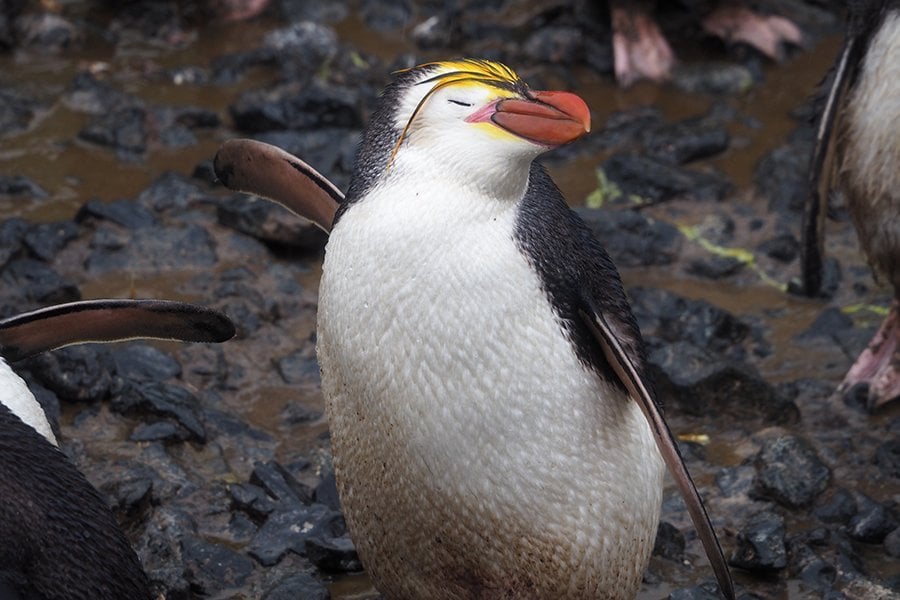
(Image Credit: Ellen Rykers)
These dapper dudes are endemic to Macquarie Island. They are chubby with thick orange bills and scruffy yellow crests slicked back like a businessman from the 60Royal penguins come ashore in October to breed, laying two eggs – although only one will survive. Chicks fledge in February, while adults stick around in March to moult. They spend winter at sea, travelling up to 10,000km during this oceanic foray.
Like their king penguin neighbours, Macquarie’s royal inhabitants were hunted for oil. Now,the birds number around 1.6 million, with Hurd Point at the southern end of the island hosting a mind-boggling 500,000 pairs. However, as they breed only at Macquarie, royal penguins are considered at conservation risk.
Royal penguins are closely related to Macaroni penguins, with some even considering royals to be a subspecies or colour morph of Macaroni penguin. They can be distinguished by their faces: Macaroni penguins have a black face and chin, while royals have white facial colouring.
Eastern rockhopper penguin
Eudyptes chrysocome filholi

(Image Credit: Ellen Rykers)
Named for their endearing habit of leaping across rocky terrain, rockhoppers are one of the more athletic penguin species on land (but they’re still more at home in the water). They perform these feats of agility all while being the smallest crested penguin species.
There are three rockhopper forms – all with spiky punk hairdos – and their taxonomic status isn’t settled. But it’s the eastern rockhoppers who live on Macquarie Island, Heard Island and the McDonald Islands.
Eastern rockhoppers have suffered a major population decline in recent years. Climate change is the likely culprit, which affects food availability. Competition with commercial fisheries may also be an issue – highlighting the importance of marine protected areas to safeguard these adorable boulder-bouncers.
Gentoo penguin
Pygoscelis papua
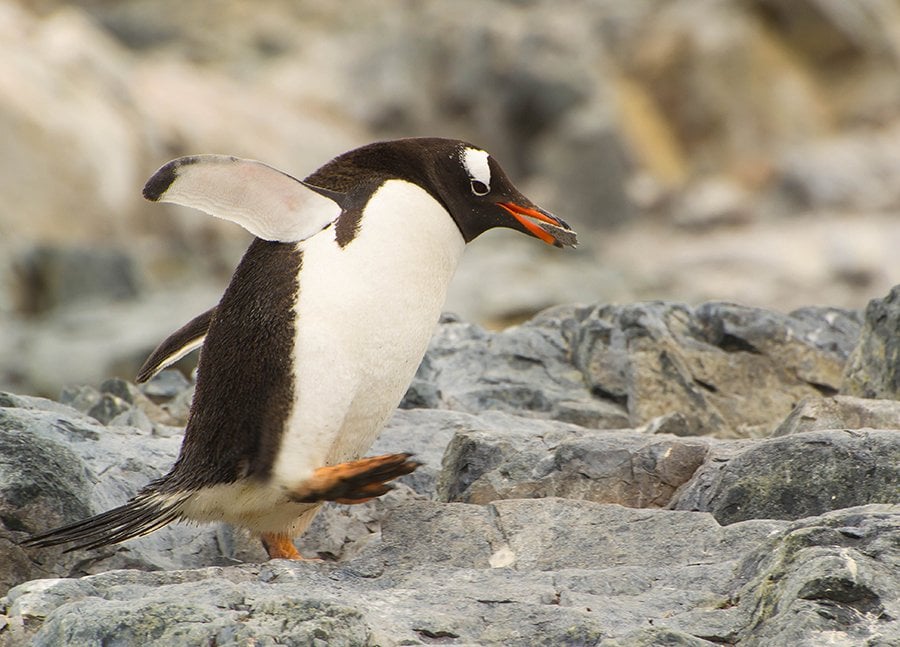
(Image Credit: kerryinlondon/Flickr)
Gentoo penguins are easily recognisable with their orange bill, white eye patches, peachy- pink feet and long fan-tail that sways when they waddle. They’re easy to hear, too, with a loud trumpeting honk. At sea, gentoos are known for their speed. They are the fastest of all penguins in the water, reaching 36km/h.
Gentoos are social breeders, building their pebble-nests in colonies. Pebbles are a gentoo’s prized possession: with the right stone, a male can woo a female. Because of this, stones are intensely guarded and the subject of many a neighbourly dispute. Couples are monogamous, and infidelity is a big no-no, with cheating penguins being punished with exile from the colony.
Small colonies of gentoo penguins breed on Macquarie and Heard Islands.
Macaroni penguin
Eudyptes chrysolophus
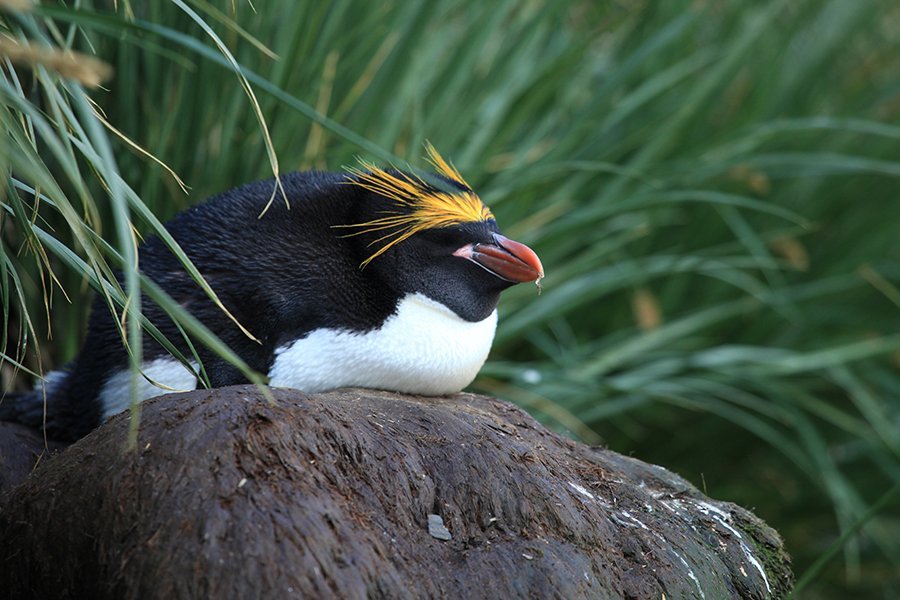
(Image Credit: Liam Quinn/Flickr)
Macaroni penguins resemble their royal relatives, with scruffy yellow plumes. As mentioned, they can be differentiated by facial colouring: macaronies have black faces, while royals have whiter visages. Their distinctive golden crest led to the “macaroni” moniker, which refers to a man with flamboyant fashion sense.
Like all penguins, macaronies spend the majority of their life at sea, but when they come ashore, they engage in spirited courtship with coordinated head bops and preening. Male macaroni penguins are stay-at- home dads, taking care of most of the parental responsibilities.
In the Australian realm, macaroni penguins are found on Heard Island and McDonaldIslands. Although macaroni penguins are the most numerous penguin species in the world, their numbers are declining. Scientists aren’t sure exactly why, but climate change may be affecting the abundance and distribution of their favoured prey. Industrial fishing for finfish and krill is another potential factor.
Adélie penguin
Pygoscelis adeliae
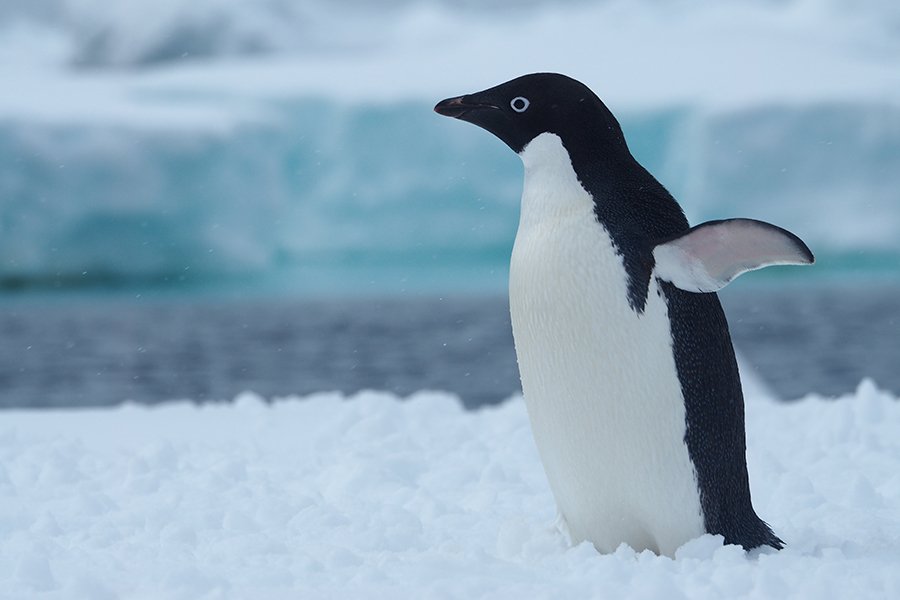
(Image Credit: Ellen Rykers)
A truly Antarctic species, Adélies can be found breeding in their thousands in the Australian Antarctic Territory during summer. About 80,000 congregate along the coast near Mawson Station. Although they’re adapted for swimming, Adélie penguins are also accomplished long-distance walkers, with some traversing 50km to reach the open water to feed. Of course, when the snow is thick enough, Adélies will plonk on their tums and toboggan.
These mid-sized penguins are outfitted in classic black-and- white tuxedos. But don’t let their formal get-up fool you: Adélies are cheeky. Their antics and inquisitive nature delighted the early Antarctic explorers, while their depraved mating habits shocked scientists and were deemed too “indecent” for publication in 1912.
During winter, they migrate to the ice edge to forage for food. They rely largely on krill as a food source. While Adélie numbers appear to be increasing in East Antarctica, there have been a few mass mortality events over the last few years that have sparked alarm among conservationists and scientists. As climate change transforms their icy world, some have suggested that marine protected areas in East Antarctica could mitigate impacts on Adélies and other penguins, by ensuring their food sources are not exploited for commercial purposes.
Emperor penguin
Aptenodytes forsteri

(Image Credit: Christopher Michel/Flickr)
Perhaps the most iconic of all penguins, emperor colonies dot the fast ice of the Australian Antarctic Territory during the depths of winter. Emperor penguins are the largest species, with some big boys weighing in at 40kg.
Emperor penguins are famous for their incredible breeding habits: they breed during the dark winter in some of the harshest weather conditions imaginable. To endure blizzards with 200km/h winds, emperor penguins sport some serious insulation in the form of specially-adapted feather layers. But they also display remarkable cooperation – in stark contrast to the territorial nature of other penguins – in the form of huddling. Emperor penguins will pack together to keep warm, squeezing in as many as ten penguins per square metre. The huddle will continuously circulate, so all penguins get their turn in the toasty centre.
Emperor penguins require a lot of food to maintain their chunky physique: as much as 6kg per day! To catch their tucker, emperors generally dive between 150–250m for three to six minutes. But the deepest dive recorded is a whopping 565m, and the longest clocks in at 22 minutes.
Emperor penguin populations are predicted to undergo rapid decline over the coming years due to climate change. As with Adélies, marine protected areas could help to safeguard their food sources and partially mitigate some of these adverse effects.




